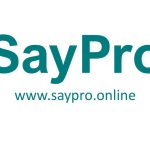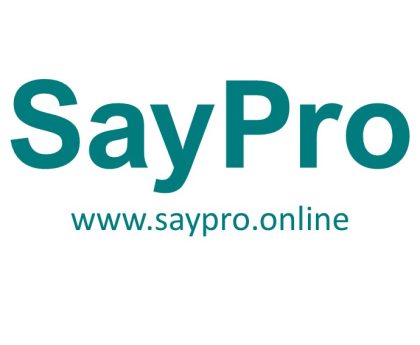SayPro Tasks to be Done for the Period Develop brand guidelines, ensuring that all aspects of the brand’s visual identity are included from SayPro Monthly January SCMR-17 SayPro Monthly Branding: Logo design, brand strategy, and corporate identity by SayPro Online Marketplace Office under SayPro Marketing Royalty SCMR
Objective:
The goal of this task is to create a comprehensive set of brand guidelines that will serve as a definitive resource for anyone involved in creating, implementing, or maintaining the SayPro brand identity. These guidelines should ensure consistency in visual elements across all platforms, materials, and touchpoints, while also communicating SayPro’s mission, values, and personality. The guidelines should reflect the updated logo, color schemes, typography, imagery, and other elements of the corporate identity.
1. Identify Key Brand Elements to Include in the Guidelines
Before beginning the creation of the brand guidelines, it is crucial to determine which brand elements need to be documented and standardized. The guidelines should cover all visual aspects that represent the SayPro brand.
Key Steps:
- Logo Usage:
- Provide clear instructions on how to use the SayPro logo, including:
- Clear space: Specify the minimum space required around the logo to ensure it is always legible.
- Sizing: Define minimum and maximum logo sizes for different applications (e.g., print, digital).
- Incorrect Usage: Examples of how the logo should not be used (e.g., distortion, color changes).
- Variations: Guidelines for different versions of the logo, such as horizontal or vertical layouts, monochrome, or full-color versions.
- Provide clear instructions on how to use the SayPro logo, including:
- Color Palette:
- Define the primary and secondary color palettes. For each color, include:
- Pantone (PMS), CMYK, RGB, and Hex values.
- Usage Recommendations: How and where to use each color (e.g., background, typography, accent colors).
- Complementary Colors: Identify any additional colors that work well with the primary palette.
- Define the primary and secondary color palettes. For each color, include:
- Typography:
- Specify the primary and secondary fonts for the brand, including:
- Font Families: Both web-safe and print fonts.
- Usage Guidelines: When and where to use different fonts (e.g., headings, body text, captions).
- Typography Style: Guidelines for font weights, sizes, and line heights to ensure readability and consistency.
- Specify the primary and secondary fonts for the brand, including:
- Imagery and Photography:
- Provide direction on the style of imagery that should be used in conjunction with the brand. Include:
- Photography Style: Whether images should be high-contrast, minimalistic, warm, or cool, depending on the brand’s personality.
- Illustrations: Whether illustrations or icons are part of the visual language.
- Image Treatment: If images should be black and white, muted, or vibrant, etc.
- Provide direction on the style of imagery that should be used in conjunction with the brand. Include:
- Iconography and Graphics:
- Create standards for any icons or graphic elements used by SayPro, including:
- Icon Style: Flat, line-based, 3D, etc.
- Size Guidelines: Uniform sizing for icons across all platforms and applications.
- Spacing and Placement: Rules for consistent spacing between icons and other elements.
- Create standards for any icons or graphic elements used by SayPro, including:
- Brand Patterns and Textures:
- If applicable, define any patterns or textures that are part of SayPro’s visual identity, including:
- Usage Guidelines: Where and how to incorporate patterns or textures (e.g., backgrounds, overlays).
- Visual Consistency: Ensure these elements do not overwhelm the main content and remain consistent across applications.
- If applicable, define any patterns or textures that are part of SayPro’s visual identity, including:
- Tone and Voice:
- Even though tone and voice are not strictly visual, it’s important to define the brand’s personality to maintain consistency across all materials. This section should include:
- Language Style: Whether the brand tone is formal, friendly, professional, witty, etc.
- Brand Messaging: Guidelines for the types of messaging that are on-brand (e.g., casual vs. formal language).
- Social Media Guidelines: Tone of voice specific to social media platforms.
- Even though tone and voice are not strictly visual, it’s important to define the brand’s personality to maintain consistency across all materials. This section should include:
2. Document the Visual Identity Guidelines
Once the key elements have been identified, the next step is to begin drafting the actual brand guidelines document. The document should be visually engaging and structured in a way that is easy for employees, designers, and partners to reference. Ensure the document reflects the brand’s identity and serves as a practical resource.
Key Steps:
- Cover Page and Introduction:
- The brand guidelines should begin with an introduction that explains the purpose of the document and the importance of adhering to the guidelines. Include a cover page with the SayPro logo and a brief statement about the brand’s mission and values.
- Logo Section:
- This section should detail how the SayPro logo can be used in various contexts. Include visual examples of correct and incorrect logo applications. Provide color versions and monochrome versions of the logo, as well as instructions on how and when to use each.
- Color Palette Section:
- Present the primary and secondary colors with clear visual swatches. Include the corresponding color codes (Pantone, CMYK, RGB, and Hex) to ensure accurate reproduction. Provide recommendations for color combinations, background color usage, and contrast considerations.
- Typography Section:
- Display the fonts used for the brand, detailing the specific font family, weights, and sizes. Include example text to show how the font should look in different contexts (e.g., headings, subheadings, and body text). Provide guidance on font pairings for different types of content (e.g., print vs. digital).
- Imagery and Photography Section:
- Offer visual examples of acceptable photography styles, showcasing how images should be treated and aligned with the brand’s aesthetic. If there are specific types of images to avoid (e.g., stock photography), provide examples of what to steer clear of.
- Iconography Section:
- Document how icons should be designed and used, along with visual examples. Include guidelines on sizes, colors, and spacing to ensure consistency.
- Brand Patterns and Textures Section:
- If SayPro uses patterns or textures, this section should detail their use cases, with visual examples of how they integrate into various marketing materials (e.g., website backgrounds, brochures, etc.).
- Brand Tone and Voice Section:
- Even though this is a more conceptual part of the guidelines, this section should outline the brand’s tone, style of communication, and key phrases. Include examples of both on-brand and off-brand language for clarity.
3. Ensure Consistency Across All Platforms and Touchpoints
The brand guidelines should be designed to ensure that the visual identity is applied consistently across all platforms, materials, and touchpoints, whether internal or external. This includes websites, digital marketing, print materials, packaging, and social media.
Key Steps:
- Cross-Platform Consistency:
- Ensure the brand guidelines account for different formats, including print (brochures, business cards) and digital (websites, email templates, social media graphics).
- Provide specific guidelines for each platform, such as:
- Web Design: Logo usage in web headers, background colors, and typography for readability on screens.
- Print Design: Proper color modes (CMYK vs. RGB) for brochures, banners, and business cards.
- Social Media: Consistent logo placement, profile picture sizes, and post graphics to ensure alignment with the brand.
- Use of Templates:
- Include pre-designed templates for common materials (e.g., email newsletters, social media posts, advertisements). These templates will ensure that all brand materials adhere to the visual standards set forth in the guidelines.
4. Review and Finalize the Guidelines Document
After compiling the brand elements and drafting the guidelines, it’s essential to review the document to ensure its clarity and completeness. The final document should be professional and visually aligned with SayPro’s brand identity.
Key Steps:
- Internal Review:
- Share the brand guidelines draft with internal stakeholders (e.g., marketing, design, sales) to get feedback on usability, clarity, and completeness.
- Make adjustments based on the feedback received.
- External Feedback:
- If working with external agencies or consultants, share the document with them for feedback, particularly if they’ll be applying the brand in their designs or marketing.
- Finalize the Document:
- Incorporate any final revisions and polish the document for presentation. Ensure that the guidelines are presented in a clean, organized format that is easy to follow. It could be a digital document (PDF or web-based) or a printed guide for physical reference.
5. Distribute the Brand Guidelines
Once the document is finalized, it is essential to distribute it widely within the organization and to key external partners, such as vendors, agencies, and consultants.
Key Steps:
- Internal Distribution:
- Make the brand guidelines available to all employees, ensuring that they have access to the most up-to-date standards for using the brand.
- Hold briefings or training sessions to educate teams on how to apply the guidelines in their respective roles.
- External Distribution:
- Share the brand guidelines with external partners, vendors, and collaborators who will be responsible for using or promoting the SayPro brand, such as printing companies, digital marketers, and creative agencies.
Conclusion:
Developing comprehensive brand guidelines is crucial for ensuring that SayPro’s visual identity is applied consistently and accurately across all channels. By detailing the logo usage, color palettes, typography, imagery, and other design elements, SayPro will create a unified brand presence that reflects the company’s mission and values, while also facilitating easy, consistent application by internal teams and external partners. This document will serve as the cornerstone for all visual representations of SayPro, helping to build brand recognition and trust with customers and stakeholders.



